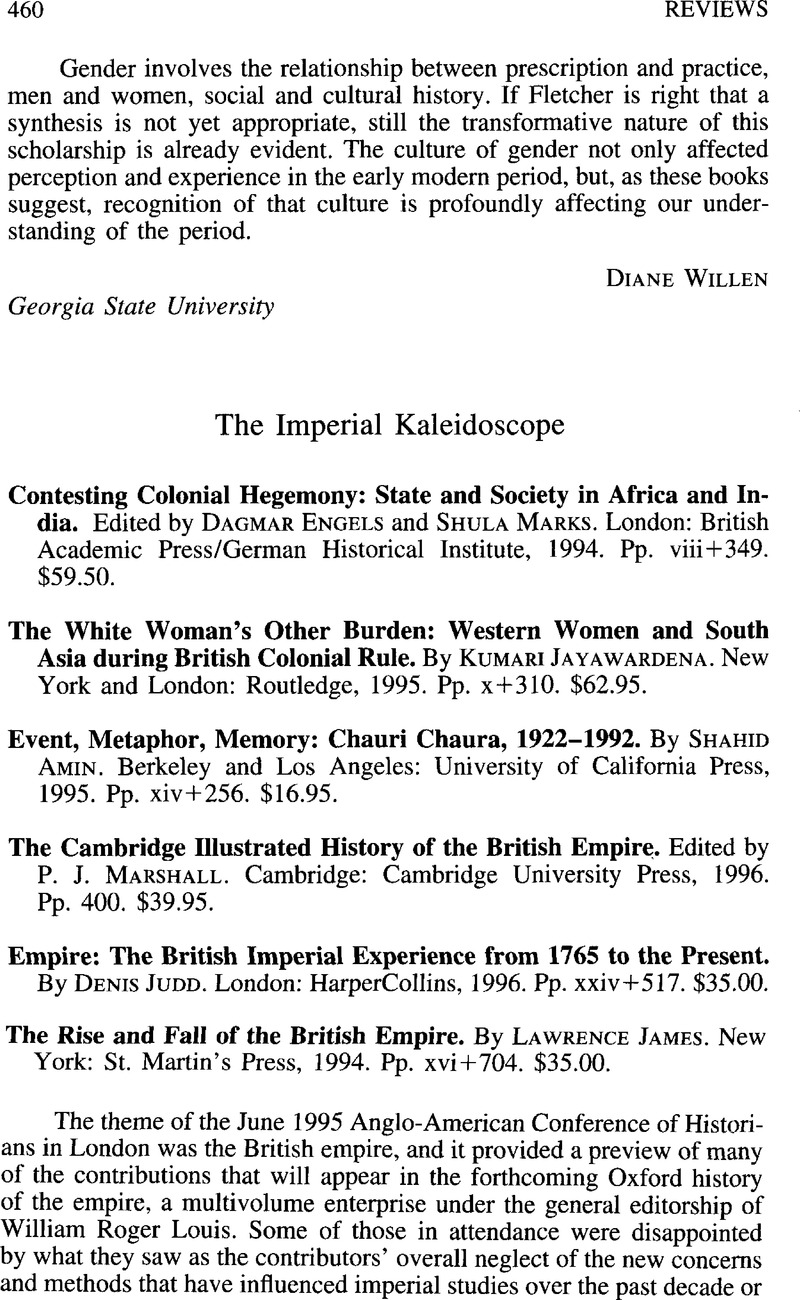Article contents
The Imperial Kaleidoscope - Contesting Colonial Hegemony: State and Society in Africa and India. Edited by Dagmar Engels and Shula Marks. London: British Academic Press/German Historical Institute, 1994. Pp. viii+349. $59.50. - The White Woman's Other Burden: Western Women and South Asia during British Colonial Rule. By Kumari Jayawardena. New York and London: Routledge, 1995. Pp. x + 310. $62.95. - Event, Metaphor, Memory: Chauri Chaura, 1922–1992. By Shahid Amin. Berkeley and Los Angeles: University of California Press, 1995. Pp. xiv + 256. $16.95. - The Cambridge Illustrated History of the British Empire. Edited by P. J. Marshall. Cambridge: Cambridge University Press, 1996. Pp. 400. $39.95. - Empire: The British Imperial Experience from 1765 to the Present. By Denis Judd. London: HarperCollins, 1996. Pp. xxiv + 517. $35.00. - The Rise and Fall of the British Empire. By Lawrence James. New York: St. Martin's Press, 1994. Pp. xvi+704. $35.00.
Published online by Cambridge University Press: 10 January 2014
Abstract

- Type
- Reviews
- Information
- Copyright
- Copyright © North American Conference of British Studies 1998
References
1 Beloff, Max, “The British Empire,” History Today 46, no. 2 (February 1996): 14Google Scholar. This essay is a version of his plenary address.
2 The June 1997 Anglo-American Conference revisited some of these issues under the theme “Connexions: European Peoples and the Non-European World,” confirming the revival of interest in imperial history.
3 The volume derives from a conference sponsored by the German Historical Institute, London, in 1989. In the five years it took to bring the volume to press, some of the contributions surfaced elsewhere. David Arnold's essay, for example, appears in revised form in his Colonizing the Body: State Medicine and Epidemic Disease in Nineteenth-Century India (Berkeley and Los Angeles, 1993)Google Scholar.
4 For a far more critical assessment of the relationship between British feminists and Indian women, see Burton, Antoinette, Burdens of Empire: British Feminists, Indian Women, and Imperial Culture, 1865–1915 (Chapel Hill, N.C., 1994)Google Scholar, a work that uses the term “burden” in its title for ironic effect. Also see Chaudhuri, Nupur and Strobel, Margaret, eds., Western Women and Imperialism: Complicity and Resistance (Bloomington, Ind., 1992)Google Scholar; Ware, Vron, Beyond the Pale: White Women, Racism and History (London, 1992)Google Scholar; and a recent essay by Burton, Antoinette, “Contesting the Zenana: The Mission to Make ‘Lady Doctors for India,’ 1874–1885,” Journal of British Studies 35, no. 3 (July 1996): 368–97CrossRefGoogle Scholar.
5 See Prakash, Gyan, “Subaltern Studies as Postcolonial Criticism,” American Historical Review 99, no. 5 (December 1994): 1475–90CrossRefGoogle Scholar; Cooper, Frederick, “Conflict and Connection: Rethinking Colonial African History,” American Historical Review 99, no. 5 (December 1994): 1516–45CrossRefGoogle Scholar; and Mallon, Florencia E., “The Promise and Dilemma of Subaltern Studies: Perspectives from Latin American History,” American Historical Review 99, no. 5 (December 1994): 1491–1515CrossRefGoogle Scholar.
6 Morris, James, Heaven's Command: An Imperial Progress (New York, 1973)Google Scholar, Pax Britannica: The Climax of an Empire (New York, 1968)Google Scholar, Farewell the Trumpets: An Imperial Retreat (New York, 1978)Google Scholar.
- 3
- Cited by




